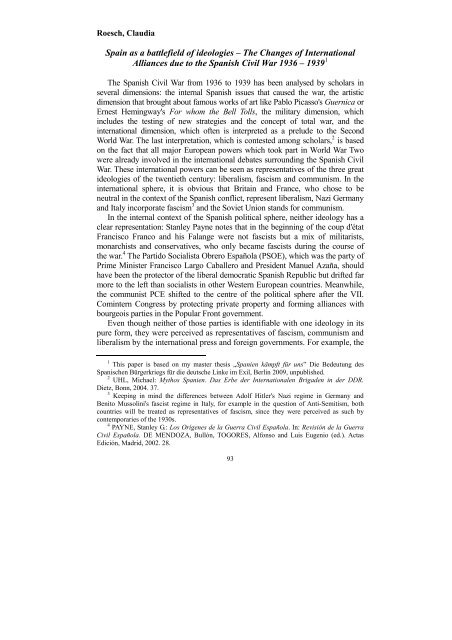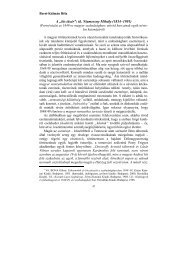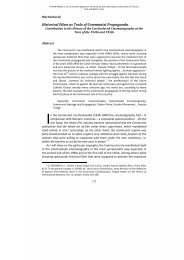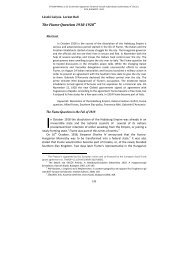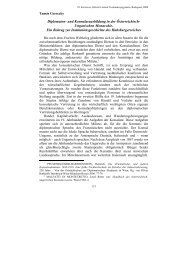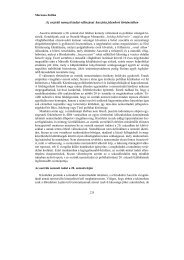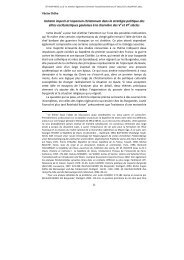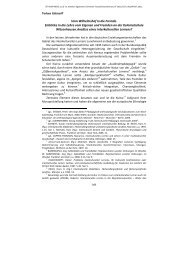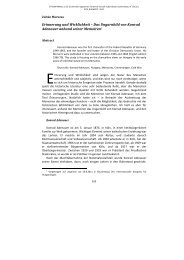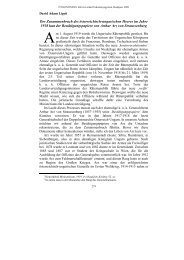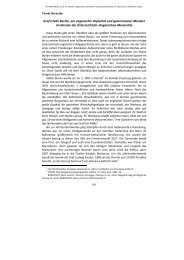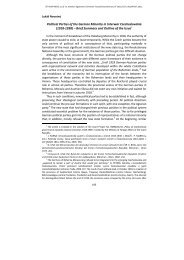The Molotov-Ribbentrop Pact - ELTE BTK Történelem Szakos Portál
The Molotov-Ribbentrop Pact - ELTE BTK Történelem Szakos Portál
The Molotov-Ribbentrop Pact - ELTE BTK Történelem Szakos Portál
You also want an ePaper? Increase the reach of your titles
YUMPU automatically turns print PDFs into web optimized ePapers that Google loves.
Roesch, Claudia<br />
Spain as a battlefield of ideologies – <strong>The</strong> Changes of International<br />
Alliances due to the Spanish Civil War 1936 – 1939 1<br />
<strong>The</strong> Spanish Civil War from 1936 to 1939 has been analysed by scholars in<br />
several dimensions: the internal Spanish issues that caused the war, the artistic<br />
dimension that brought about famous works of art like Pablo Picasso's Guernica or<br />
Ernest Hemingway's For whom the Bell Tolls, the military dimension, which<br />
includes the testing of new strategies and the concept of total war, and the<br />
international dimension, which often is interpreted as a prelude to the Second<br />
World War. <strong>The</strong> last interpretation, which is contested among scholars, 2 is based<br />
on the fact that all major European powers which took part in World War Two<br />
were already involved in the international debates surrounding the Spanish Civil<br />
War. <strong>The</strong>se international powers can be seen as representatives of the three great<br />
ideologies of the twentieth century: liberalism, fascism and communism. In the<br />
international sphere, it is obvious that Britain and France, who chose to be<br />
neutral in the context of the Spanish conflict, represent liberalism, Nazi Germany<br />
and Italy incorporate fascism 3 and the Soviet Union stands for communism.<br />
In the internal context of the Spanish political sphere, neither ideology has a<br />
clear representation: Stanley Payne notes that in the beginning of the coup d'état<br />
Francisco Franco and his Falange were not fascists but a mix of militarists,<br />
monarchists and conservatives, who only became fascists during the course of<br />
the war. 4 <strong>The</strong> Partido Socialista Obrero Española (PSOE), which was the party of<br />
Prime Minister Francisco Largo Caballero and President Manuel Azaña, should<br />
have been the protector of the liberal democratic Spanish Republic but drifted far<br />
more to the left than socialists in other Western European countries. Meanwhile,<br />
the communist PCE shifted to the centre of the political sphere after the VII.<br />
Comintern Congress by protecting private property and forming alliances with<br />
bourgeois parties in the Popular Front government.<br />
Even though neither of those parties is identifiable with one ideology in its<br />
pure form, they were perceived as representatives of fascism, communism and<br />
liberalism by the international press and foreign governments. For example, the<br />
1<br />
This paper is based on my master thesis „Spanien kämpft für uns” Die Bedeutung des<br />
Spanischen Bürgerkriegs für die deutsche Linke im Exil, Berlin 2009, unpublished.<br />
2<br />
UHL, Michael: Mythos Spanien. Das Erbe der Internationalen Brigaden in der DDR.<br />
Dietz, Bonn, 2004. 37.<br />
3<br />
Keeping in mind the differences between Adolf Hitler's Nazi regime in Germany and<br />
Benito Mussolini's fascist regime in Italy, for example in the question of Anti-Semitism, both<br />
countries will be treated as representatives of fascism, since they were perceived as such by<br />
contemporaries of the 1930s.<br />
4<br />
PAYNE, Stanley G.: Los Orígenes de la Guerra Civil Española. In: Revisión de la Guerra<br />
Civil Española. DE MENDOZA, Bullón, TOGORES, Alfonso and Luis Eugenio (ed.). Actas<br />
Edición, Madrid, 2002. 28.<br />
93


